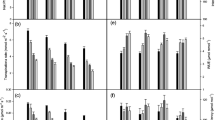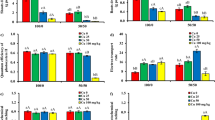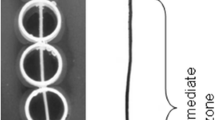Abstract
Although it is known that cations such as calcium (Ca) and magnesium (Mg) can alleviate metal toxicity in plants, much uncertainty remains regarding the mechanisms by which this alleviation occurs. In this study, three plant species, cowpea (Vigna unguiculata. cv. White Caloona), soybean (Glycine max. cv. Bunya), and wheat (Triticum. cv. Axe), were used to examine growth in nutrient solutions containing a series of cations (Ca and Mg) and toxicants (Al and Cu). The addition of Ca and Mg increased Al3+ activities that induced 50% plant root elongation rate decline (EC50) from 4.0, 4.2, 0.34 to 31, 22, 9.4 for cowpea, soybean, wheat respectively. However, when expressed as the Al3+ activity at the root-cell plasma membrane (PM) surface, the addition of Ca and Mg increased Al sensitivity. In regression models, plant root elongation rate (RER) had higher R2 values with Al3+ activity at the PM than with Al3+ activity in the bulk solutions (0.60, 0.58, 0.93 for cowpea, soybean, wheat respectively). For Cu, the addition of Ca and Mg alleviated its phytotoxicity when expressed as the Cu2+ activity in the bulk-phase solutions for both cowpea and wheat. However, in soybean, the addition of Mg did not alter Cu toxicity when expressed as the Cu2+ bulk activity. Generally, the metal activity at the outer PM surface of the root cells is a better predictor for their phytotoxicity than the activity in bulk solution (R2=0.80, 0.80, 0.87 for cowpea, soybean, wheat respectively). These results supported the concept that the strength of alleviation of Ca and Mg cations depends on both the plant species and the toxicants that they alleviate. The different mechanisms should be fully considered in relevant assessments of trace metal toxicity in plants.












Similar content being viewed by others
Data availability
All data generated or analyzed during this study are included in this published article [and its supplementary information files].
Abbreviations
- PM:
-
plasma membrane
- RER:
-
root elongation rate
- EC50 :
-
50% root elongation rate decline
References
Ali B, Hasan SA, Hayat S, Hayat Q, Yadav S, Fariduddin Q, Ahmad A (2008) A role for brassinosteroids in the amelioration of aluminium stress through antioxidant system in mung bean (Vigna radiata L. Wilczek). Environ Exp Bot 62:153–159. https://doi.org/10.1016/j.envexpbot.2007.07.014
Alva A, Asher C, Edwards D (1986) The role of calcium in alleviating aluminium toxicity. Aust J Agric Res 37:375–382. https://doi.org/10.1071/AR9860375
Boaretto RM, Franz WR, Guilherme AF, Ricardo AA, Jose AQ, Dirceu MJ (2020) The possible role of extra magnesium and nitrogen supply to alleviate stress caused by high irradiation and temperature in lemon trees. Plant Soil 457:57–70. https://doi.org/10.1007/s11104-020-04597-y
Bose J, Babourina O, Rengel Z (2011) Role of magnesium in alleviation of aluminium toxicity in plants. J Exp Bot 62:2251–2264. https://doi.org/10.1093/jxb/erq456
Chen BC, Wang PJ, Ho PC, Juang KW (2017) Nonlinear biotic ligand model for assessing alleviation effects of Ca, Mg, and K on Cd toxicity to soybean roots. Ecotoxicology 26:942–955. https://doi.org/10.1007/s10646-017-1823-2
Di Toro DM, Allen HE, Bergman HL, Meyer JS, Paquin PR, Santore RC (2001) Biotic ligand model of the acute toxicity of metals. 1. Technical Basis. Environ Toxicol Chem 20:2383–2396. https://doi.org/10.1002/etc.5620201034
Foy CD (1992) Soil Chemical Factors Limiting Plant Root Growth. In: Hatfield JL, Stewart BA (eds) Limitations to plant root growth. Springer New York, New York, NY, pp 97–149. https://doi.org/10.1007/978-1-4612-2894-3_5
Juang KW, Lee YI, Lai HY, Chen BC (2014) Influence of magnesium on copper phytotoxicity to and accumulationand translocation in grapevines. Ecotoxicol Environ Saf 104:36–42. https://doi.org/10.1016/j.ecoenv.2014.02.008
Kinraide TB (1998) Three mechanisms for the calcium alleviation of mineral toxicities. Plant Physiol 118:513–520. https://doi.org/10.1104/pp.118.2.513
Kinraide TB (1999) Interactions among Ca2+, Na+ and K+ in salinity toxicity: quantitative resolution of multiple toxic and ameliorative effects. J Exp Bot 50:1495–1505. https://doi.org/10.1093/jxb/50.338.1495
Kinraide TB (2006) Plasma membrane surface potential (ψpm) as a determinant of ion bioavailability: a critical analysis of new and published toxicological studies and a simplified method for the computation of plant ψpm. Environ Toxicol Chem 25:3188–3198. https://doi.org/10.1897/06-103R.1
Kinraide TB, Wang P (2010) The surface charge density of plant cell membranes (σ): an attempt to resolve conflicting values for intrinsic σ. J Exp Bot 61:2507–2518. https://doi.org/10.1093/jxb/erq082
Kinraide TB, Pedler JF, Parker DR (2004) Relative effectiveness of calcium and magnesium in the alleviation of rhizotoxicity in wheat induced by copper, zinc, aluminum, sodium, and low pH. Plant Soil 259:201–208. https://doi.org/10.1023/B:PLSO.0000020972.18777.99
Kopittke PM, Blamey FPC, Asher CJ, Menzies NW (2010) Trace metal phytotoxicity in solution culture: a review. J Exp Bot 61:945–954. https://doi.org/10.1093/jxb/erp385
Kopittke PM, Blamey F, McKenna BA, Wang P, Menzies NW (2011a) Toxicity of metals to roots of cowpea in relation to their binding strength. Environ Toxicol Chem 30:1827–1833. https://doi.org/10.1002/etc.557
Kopittke PM, Kinraide TB, Wang P, Blamey FPC, Reichman SM, Menzies NW (2011b) Alleviation of Cu and Pb rhizotoxicities in cowpea (Vigna unguiculata) as related to ion activities at root-cell plasma membrane surface. Environ Sci Technol 45:4966–4973. https://doi.org/10.1021/es1041404
Kopittke PM, Wang P, Menzies NW, Naidu R, Kinraide TB (2014) A web-accessible computer program for calculating electrical potentials and ion activities at cell-membrane surfaces. Plant Soil 375:35–46. https://doi.org/10.1007/s11104-013-1948-x
Lin Y, Di Toro DM, Allen HE (2015) Development and validation of a terrestrial biotic ligand model for Ni toxicity to barley root elongation for non-calcareous soils. Environ Pollut 202:41–49. https://doi.org/10.1016/j.envpol.2015.03.015
Llamas A, Ullrich CI, Sanz A (2000) Cd2+ effects on transmembrane electrical potential difference, respiration and membrane permeability of rice (Oryza sativa L) roots. Plant Soil 219:21–28. https://doi.org/10.1023/A:1004753521646
Marouane BM, Inès K, Ezzedine EF, Abdelilah C (2018) Alleviation of copper toxicity in germinating pea seeds by IAA, GA3, Ca and citric acid. J Plant Interact 13(1):21–29. https://doi.org/10.1080/17429145.2017.1410733
Nazar R, Iqbal N, Masood A, Khan MIR, Syeed S, Khan NA (2012) Cadmium toxicity in plants and role of mineral nutrients in its alleviation. Am J Plant Sci 3:1476–1489. https://doi.org/10.4236/ajps.2012.310178
Ouzounidou G, Čiamporová M, Moustakas M, Karataglis S (1995) Responses of maize (Zea mays L.) plants to copper stress – I. Growth, mineral content and ultrastructure of roots. Environ Exp Bot 35:167–176. https://doi.org/10.1016/0098-8472(94)00049-B
Paquin PR, Gorsuch JW, Apte S, Batley GE, Bowles KC, Campbell PGC, Delos CG, di Toro DM, Dwyer RL, Galvez F, Gensemer RW, Goss GG, Hogstrand C, Janssen CR, McGeer JC, Naddy RB, Playle RC, Santore RC, Schneider U, Stubblefield WA, Wood CM, Wu KB (2002) The biotic ligand model: a historical overview. Comparative Biochemistry and Physiology Part C: Toxicology & Pharmacology 133:3–35. https://doi.org/10.1016/S1532-0456(02)00112-6
Pedler JF, Kinraide TB, Parker DR (2004) Zinc rhizotoxicity in wheat and radish is alleviated by micromolar levels of magnesium and potassium in solution culture. Plant Soil 259:191–199. https://doi.org/10.1023/B:PLSO.0000020958.42158.f5
Rengel Z (1992) Role of calcium in aluminium toxicity. New Phytol 121:499–513. https://doi.org/10.1111/j.1469-8137.1992.tb01120.x
Silva IR, Smyth TJ, Israel DW, Raper CD, Rufty TW (2001a) Magnesium ameliorates aluminum rhizotoxicity in soybean by increasing citric acid production and exudation by roots. Plant Cell Physiol 42:546–554. https://doi.org/10.1093/pcp/pce067
Silva IR, Smyth TJ, Israel DW, Raper CD, Rufty TW (2001b) Magnesium is more efficient than calcium in alleviating aluminum rhizotoxicity in soybean and its ameliorative effect is not explained by the Gouy-Chapman-Stern model. Plant Cell Physiol 42:538–545. https://doi.org/10.1093/pcp/pce066
Tyerman SD, Skerrett M, Garrill A, Findlay GP, Leigh RA (1997) Pathways for the permeation of Na+ and Cl- into protoplasts derived from the cortex of wheat roots. J Exp Bot 48:459–480 https://www.jstor.org/stable/23695626
Wang P, Zhou D, Kinraide TB, Luo X, Li L, Li D, Zhang H (2008) Cell membrane surface potential (ψ0) plays a dominant role in the phytotoxicity of copper and arsenate. Plant Physiol 148:2134–2143. https://doi.org/10.1104/pp.108.127464
Wang P, Kinraide TB, Zhou D, Kopittke PM, Peijnenburg WJGM (2011) Plasma membrane surface potential: dual effects upon ion uptake and toxicity. Plant Physiol 155:808–820. https://doi.org/10.1104/pp.110.165985
Wang P, Menzies NW, Lombi E, Sekine R, Blamey FPC, Hernandez-Soriano MC, Cheng M, Kappen P, Peijnenburg WJGM, Tang C, Kopittke PM (2015) Silver sulfide nanoparticles (Ag2S-NPs) are taken up by plants and are phytotoxic. Nanotoxicology 9:1041–1049. https://doi.org/10.3109/17435390.2014.999139
Weng LP, Wolthoorn A, Lexmond TM, Temminghoff EJM, van Riemsdijk WH (2004) Understanding the effects of soil characteristics on phytotoxicity and bioavailability of nickel using speciation models. Environ Sci Technol 38:156–162. https://doi.org/10.1021/es030053r
Yermiyahu U, Kinraide TB (2005) Chapter 12 - Binding and electrostatic attraction of trace elements to plant root surfaces. In: Huang PM, Gobran GR (eds) Biogeochemistry of Trace Elements in the Rhizosphere. Elsevier, Amsterdam 365-389 https://doi.org/10.1016/B978-044451997-9/50014-3
Acknowledgements
We are thankful that Professor Peter Kopittke provided assistance for the experimental work at the University of Queensland in Australia. Data can be accessed via the Supplementary Material.
Author information
Authors and Affiliations
Contributions
ZL: conceptualization, methodology, investigation, software, data curation, visualization, and writing—original draft preparation. BH: supervision and writing—reviewing and editing. All authors read and approved the final manuscript.
Corresponding author
Ethics declarations
Ethics approval and consent to participate
Not applicable
Consent for publication
Not applicable
Competing interests
The authors declare no competing interests.
Disclaimer
We declare that we have no financial and personal relationships with other people or organizations that can inappropriately influence our work.
Additional information
Responsible Editor: Gangrong Shi
Publisher’s note
Springer Nature remains neutral with regard to jurisdictional claims in published maps and institutional affiliations.
Supplementary Information
ESM 1
(DOCX 27 kb)
Rights and permissions
About this article
Cite this article
Li, Z., Hu, B. Electrical properties of plant root cell plasma membrane influence the alleviation of Al and Cu phytotoxicity by Ca and Mg cations. Environ Sci Pollut Res 28, 48022–48037 (2021). https://doi.org/10.1007/s11356-021-14001-6
Received:
Accepted:
Published:
Issue Date:
DOI: https://doi.org/10.1007/s11356-021-14001-6




